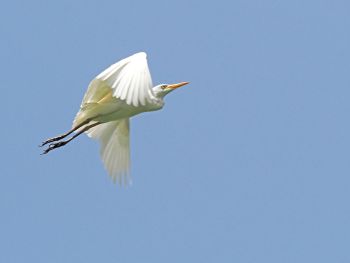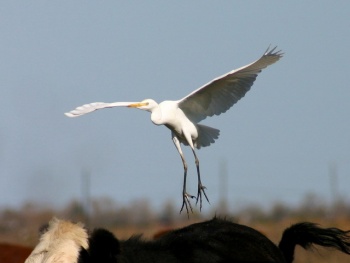- Ardea ibis
Bubulcus ibis, Ardeola ibis, Egretta ibis
Identification
Length 42–56 cm (16-22 in), wingspan about 90-96 cm.
The Cattle Egret has a compact build with white plumage, yellow bill, and mostly yellow legs. One characteristic feature is the short stubby bill with obvious feathering extending out along the lower mandible to the mid point.
When breeding, buff plumes develop on the crown and lower back, and parts of the breast also develop buff tones (or in some birds, more rusty-brown). In high breeding, bill and legs become reddish; however, this is held much shorter than the plumage.
Females in winter plumage lack extended throat feathers seen in the male, but otherwise, the sexes are similar.

Photo © by ammadoux
Public Garden - Jeddah, Saudi Arabia, 21 May 2020
Juvenile birds have a greyish-black wash to bill and legs.
Similar Species
Eastern Cattle Egret has longer legs and bill but shorter tail. The longer legs past the tail are especially noticeable in flight. In breeding, Eastern C.E. has much stronger coloration that covers a larger part of the bird, while birds in basic plumage cannot be distinguished by coloration. The overall size might also be larger or the way the bird holds itself may make it appear so.
Juvenile birds with mostly dark bill can be confused with immature Little Blue Heron. Adults in non-breeding plumage may be confused with the much larger white morph of the Great Blue Heron or with the Great Egret. However Cattle Egret is much smaller and more compact. Western Cattle Egrets may also be confused with Yellow-billed Egret (which see).
Distribution
A species of Western Palearctic, Africa, and the new world.
Occurs widely in sub-Saharan Africa from Senegal to Sudan and south to South Africa including Madagascar and the Seychelles. Also breeds in north-west Africa, Iberia and parts of southern France. Has recently has begun breeding in the Canary Islands, and in western, central and northern France, Belgium, on Sardinia and most of Italy, in Hungary and Romania, and around the eastern Mediterranean in Turkey, the Middle East and Egypt. Small numbers breed in the Volga Delta of Russia.
Also widespread in the Americas. In North America occurs from south-east Canada south to Florida and the Gulf Coast and in the west breeds in California and Utah and regularly occurs north to British Columbia during post-breeding dispersal. Found throughout Mexico, Central America and the West Indies and in South America extends south to northern Argentina. Occurrence in Hawaii seems to involve descendants from birds introduced there.
The Cattle Egret found its own way to the Americas, arriving in the northeast of South America in 1877. It first arrived the USA in 1941 and nesting was noted in 1953. During the next 50 years its population expanded, making it one of the most numerous North American herons.
Recorded as a vagrant in most European countries where not regular, north to Iceland, Scandinavia and Poland, and also in the Azores, and Madeira but some reports may involve escapes. British records, (c.120), widely scattered from Sicilly north to Shetland and throughout the year. Has bred in the Cape Verde Islands and the first breeding for the Balearic Islands was recorded on Mallorca in 1997.
Taxonomy
This species was formerly included in a complex named Cattle Egret together with Eastern Cattle Egret.
Some sources place this species in genus Ardea
Subspecies
This is a monotypic species[1].
The population in the Seychelles is supposedly intermediate between Western and Eastern Cattle Egret, but closer to western in measurements; it has a heavier bill than both[8]. It was described as subspecies seychellarum but this is no longer recognized, it is now merged with the nominate subspecies, in spite of the possibility it actually originated as a result of hybridization [4].
Habitat
Freshwater margins and open grasslands. Often associates with cattle and other livestock; frequently close to human habitation. This species is likewise known to associate with large, wild grassing animals such as ungulates, hippopotamus, elephants, or rhinoceros. Breeds colonially in trees, usually close to water but often seen far from water at other seasons.
Behaviour
Has a habit of excessive-looking head movement when walking.
Diet
The Cattle Egret’s feeding grounds are usually under 20km from roost site. Typically hunts by walking steadily and stabbing at prey. It feeds on insects, especially grasshoppers, locusts and beetles, frequently scared up by a grassing, large animal.
Breeding
Colonial nester, usually with other waterbirds. Nest are built from collected or stolen (from other nests) dry sticks, weed stems and reeds; occasionally lined with grass.
Movements
Many populations are dispersive and undergo rather random movements, while others are more strongly migratory.
Vocalisation
References
- Clements, J. F., P. C. Rasmussen, T. S. Schulenberg, M. J. Iliff, T. A. Fredericks, J. A. Gerbracht, D. Lepage, A. Spencer, S. M. Billerman, B. L. Sullivan, M. Smith, and C. L. Wood. 2024. The eBird/Clements checklist of Birds of the World: v2024. Downloaded from https://www.birds.cornell.edu/clementschecklist/download/
- Gill, F, D Donsker, and P Rasmussen (Eds). 2023. IOC World Bird List (v 13.2). Doi 10.14344/IOC.ML.13.2. http://www.worldbirdnames.org/
- Beaman, M., S. Madge, K.M. Olsen. 1998. Fuglene i Europa, Nordafrika og Mellemøsten. Copenhagen, Denmark: Gads Forlag, ISBN 87-12-02276-4
- Telfair II, R. C. (2023). Western Cattle Egret (Bubulcus ibis), version 1.0. In Birds of the World (P. G. Rodewald, B. K. Keeney, S. M. Billerman, and M. A. Bridwell, Editors). Cornell Lab of Ornithology, Ithaca, NY, USA. https://doi.org/10.2173/bow.categr1.01
- Hancock, J. & J.Kushlan. 1984. The Herons Handbook. Harper & Row, New York.
- Pratt, H.D., Bruner, P., and Berrett, D.G. (1987) A Field Guide to the Birds of Hawaii and the Tropical Pacific. Princeton University Press.
- Pyle, R.L., and P. Pyle. 2017. The Birds of the Hawaiian Islands: Occurrence, History, Distribution, and Status. B.P. Bishop Museum, Honolulu, HI, U.S.A. Version 2 (1 January 2017) http://hbs.bishopmuseum.org/birds/rlp-monograph/
- Paper by Ross Ahmed describing the differences between Western and Eastern Cattle Egrets.
Recommended Citation
- BirdForum Opus contributors. (2025) Western Cattle Egret. In: BirdForum, the forum for wild birds and birding. Retrieved 11 May 2025 from https://www.birdforum.net/opus/Western_Cattle_Egret
External Links
GSearch checked for 2020 platform.1






